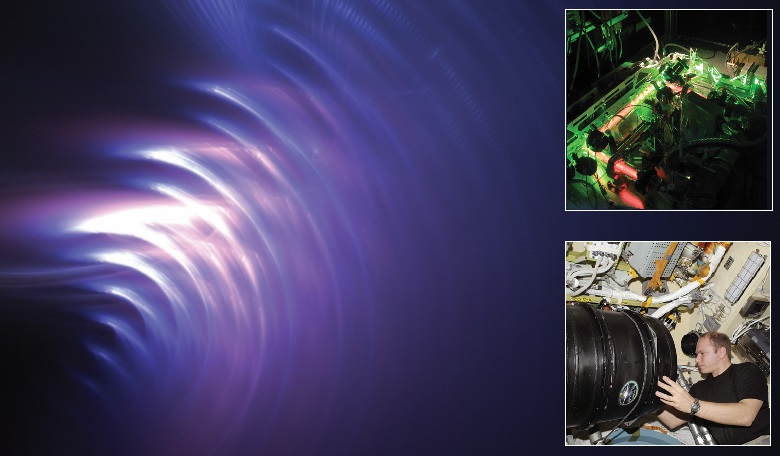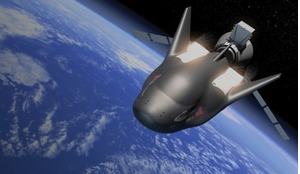What is so special about the Plasma Crystal project? Doesn’t everyone know that a ‘plasma’ typically consists of an equal number of positively and negatively charged particles (ions and electrons)? And that it is the most disordered form of matter and cannot possibly become a crystal, which is the most ordered form of matter?
And why conduct experiments in space on the ISS just to investigate what is so obviously an oxymoron? And how does this weird research justify some 1000 pages of research articles over the last 15 years? Even more strange - the discovery publication by Thomas, Morfill et al. has so far attracted 1500 citations, signifying a very high interest worldwide - what is so important?
To give an answer, let us quote two comments by Sir John Maddox from the time he was editor of the prestigious Journal Nature (News and Views, Nature 370: 411, 1994): “Most of what follows is about an experiment of outstanding ingenuity which, despite the electronic equipment no doubt accompanying it, is also simple. The word ‘elegant’ is overworked, but in this case it applies.”
He added: “What the authors themselves would like to do is to carry out their experiments in ‘microgravity’ conditions. On the face of things, it is a more deserving candidate for room in some future Space Shuttle flight than most of the others so far suggested.”
Okay, so the topic is regarded as important. And microgravity is regarded as an essential element for studying this phenomenon. So - what is it, what has been achieved and what can it be used for?
Plasma Crystal research
There are many different kinds of plasma, both naturally occurring in space and man-made. In space we have the stars (giant plasma balls), supernovae (exploding plasma clouds), star formation regions (cold partially ionised plasmas), the interstellar medium (very tenuous hot plasma), etc.
On Earth we have atmospheric lightning (short duration plasma channels), the ionosphere (ionised by radiation from the Sun), discharges in sandstorms and in volcanic plumes, etc. Man-made plasmas can be simple everyday devices like neon lights, plasma screens in televisions, production of computer chips and solar cells, etc. Plasma processes are used in multi-billion dollar industries and hopefully in the not too distant future for energy production in nuclear fusion.
Figure 1 shows a summary of different plasmas - characterised by density and temperature. Note in the top left hand corner there is a region where no plasma exists. This is the regime where the plasma would have to be in a liquid or even crystalline state. Current wisdom until the middle of the 1990s was that no plasma could exist there - provided the definition of a plasma as an ‘overall charge-neutral cloud of charged particles’ is retained.
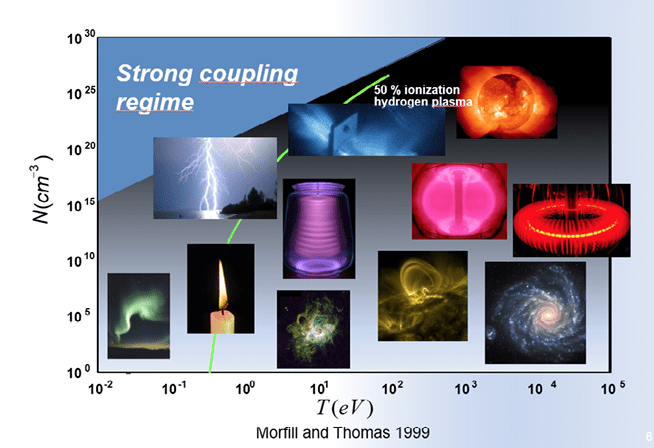 Figure 1: Different plasmas found in nature and man-made. The plasma regime covers about 30 decades in density and seven decades in temperature - far more than any other state of matter that we know. In addition, there can be chemical variations, adding a few more decades of variability. In other words ‘any one plasma is not the same as any other plasma’ - their properties can be vastly different.
Figure 1: Different plasmas found in nature and man-made. The plasma regime covers about 30 decades in density and seven decades in temperature - far more than any other state of matter that we know. In addition, there can be chemical variations, adding a few more decades of variability. In other words ‘any one plasma is not the same as any other plasma’ - their properties can be vastly different.
As so often happens in science, the breakthrough came from an unexpected direction. To obtain a crystalline state, the interaction potential between neighbouring particles has to be greater than their thermal energy - in other words, if the random (thermal) motion is too large, ordered crystal structures are impossible.
In plasmas the interaction between particles is ‘electrostatic’ - the strength is proportional to the electric charge squared. So the requirements are: the plasma must be ‘cold’ (to have a low thermal energy) and the particle charge must be high (to have a strong interaction potential).
In principle (and in hindsight) the solution is simple:
- Use a partially ionised ‘cold’ plasma, where the collisions between ions and neutrals very quickly lead to thermal equilibrium at the neutral gas temperature (this can be understood by analogy - adding a drop of hot water into a bucket of cold water and mixing will produce essentially a bucket of cold water - provided the drop is not too big).
- Then add microparticles to the plasma. The microparticles will quickly become charged up by collisions with the highly mobile electrons - and they attain several 1000 electronic charges each. The interaction potential between such microparticles is then many million times higher than that between individual ions.
Nevertheless, as a purely theoretical exercise it was difficult to convince plasma physicists - or come to that, any physicists - that this could be a way to produce plasma crystals.
As mentioned earlier - after the experimental proof of the existence of plasma crystals this scepticism turned into enthusiasm - as was expressed so eloquently by Sir John Maddox. The quest for understanding the properties of this new plasma state began and many laboratories entered the field. Figure 2 shows two pictures of ‘strongly coupled plasmas’ - on the left an ‘amorphous’ system, on the right a crystalline system surrounded by a fluid envelope.
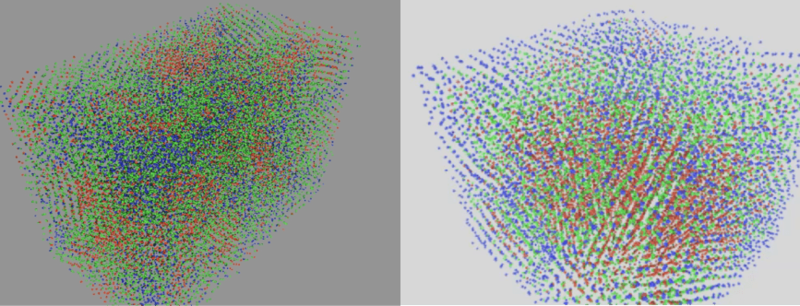 Figure 2: Two examples of three-dimensional, strongly coupled plasma clouds. Individual microparticles are shown as dots. The structural information is colour coded - red corresponds to FCC (face centered cubic) crystal structure, green is HCP (hexagonal close packed) structure and blue is fluid-like structure.
Figure 2: Two examples of three-dimensional, strongly coupled plasma clouds. Individual microparticles are shown as dots. The structural information is colour coded - red corresponds to FCC (face centered cubic) crystal structure, green is HCP (hexagonal close packed) structure and blue is fluid-like structure.
Sometime later the first efforts were started for utilising such ‘complex plasmas’ (as they were called then) to understand other generic physical strong coupling phenomena. The bonus of complex plasmas was that individual particles could be visualised using a CCD camera through a suitable optical system (the particles were ‘lit up’ with a laser) and their motion could be followed quite easily.
Therefore physicists not only had a system at their fingertips that could give insights into the ‘atomistic world’ of matter - seeing individual particles interacting, producing co-operative phenomena, phase transitions such as melting and crystallisation, phase separation, highly resolved wave phenomena, shock waves etc - they also had the possibility to study these processes down to the smallest relevant time scales given by the Einstein frequencies, a regime not accessible to experimental investigations before at that level. And that was not all - the research could also be used to study classical ‘nano-phenomena’ - e.g. what happens to collective processes such as surface tension, viscosity, etc when the system consists of fewer and fewer interacting particles. For the first time it was possible to find an answer to the question: how many particles (atoms or molecules) are necessary for the onset of cooperative phenomena (where the physics and the behaviour of matter changes in some cases dramatically) to occur? And furthermore, does the number of particles differ for different cooperative processes and, if so, why?
Below we show three examples out of several dozen where complex plasma research has yielded new physics. Space does not permit more, and whilst some of the advances are important for our understanding of fundamental physical processes (e.g. what happens at the ‘critical point’ in phase transitions, or testing the ‘ergodic hypothesis’) they are harder to describe in a context of everyday processes that are well known.
Suffice it to say that by having the ability to view such processes for the first time in real space and time at the most fundamental level - the motion of the individual interacting particles (the ‘atomistic level’) - physicists have opened up a new approach for improving our knowledge about the physics and dynamics of matter.
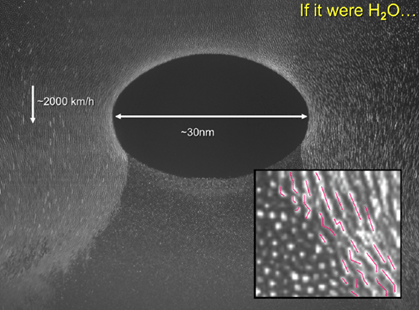 Figure 3: Complex plasma flow around an obstacle, showing typical wake effects and a shear flow interface. The insert shows a magnified segment of the shear boundary, with the collisional momentum transfer as the dominant process clearly visible. Further downstream the momentum transfer process is different - it is dominated by surface instabilities and intermixing of particle clumps. The length and velocity shown are calculated by scaling the complex plasma characteristics to those of water.
Figure 3: Complex plasma flow around an obstacle, showing typical wake effects and a shear flow interface. The insert shows a magnified segment of the shear boundary, with the collisional momentum transfer as the dominant process clearly visible. Further downstream the momentum transfer process is different - it is dominated by surface instabilities and intermixing of particle clumps. The length and velocity shown are calculated by scaling the complex plasma characteristics to those of water.
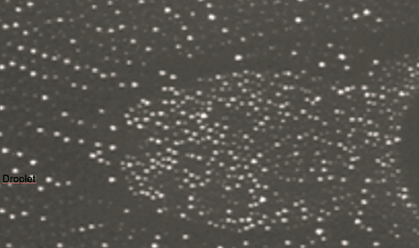 Figure 4: Phase separation between two particle populations of different size. The droplet was formed by first injecting a stream of small (3 micron size) particles into a background of larger (8 micron size) particles. The small particles were slowed down and then spontaneously coalesced into a small droplet containing about 8000 particles (in a water-oil analogy the diameter of the drop is only 20 molecules).
Figure 4: Phase separation between two particle populations of different size. The droplet was formed by first injecting a stream of small (3 micron size) particles into a background of larger (8 micron size) particles. The small particles were slowed down and then spontaneously coalesced into a small droplet containing about 8000 particles (in a water-oil analogy the diameter of the drop is only 20 molecules).
 Figure 5: Electrorheology - experiments performed by ESA astronaut Thomas Reiter. The left image shows an irregular distribution of microparticles, characteristic of an isotropic fluid phase. The right picture shows the particles aligned along the direction of an externally applied AC electric field. This is a so-called ‘string fluid’. Along the strings the fluid is difficult to compress, whereas shears are easier. By studying perturbations, field strength dependences, etc. the process can be understood in detail and optimised.
Figure 5: Electrorheology - experiments performed by ESA astronaut Thomas Reiter. The left image shows an irregular distribution of microparticles, characteristic of an isotropic fluid phase. The right picture shows the particles aligned along the direction of an externally applied AC electric field. This is a so-called ‘string fluid’. Along the strings the fluid is difficult to compress, whereas shears are easier. By studying perturbations, field strength dependences, etc. the process can be understood in detail and optimised.
From space to Earth
Developing space experiments for complex plasmas (so far three ISS laboratories - PKE, PK3-plus and PK-4 - so designated because there were two previous Russian plasma experiments PK-1 and PK-2 on the Mir Space Station) provided experience in miniaturisation and different cold plasma technologies. This experience turned out to be instrumental for developing a new application field on Earth - ‘Plasma Medicine’.
Now, it is often argued that for applications on Earth one does not have to go into space first. This is intrinsically correct. If certain applications can be carried out on Earth then there is in principle no need to take the detour into space. However, this is not how research and innovation functions. Some discoveries occur by accident (e.g. penicillin, electricity), some through transfer from one field to another (e.g. tomography) and some are simply consequences of improved technology (e.g. Atomic Force Microscopy). And so - inevitably - some of the results from space, whether technological advances or a better generic understanding of physical, chemical or biological processes, will find their way into applications on Earth.
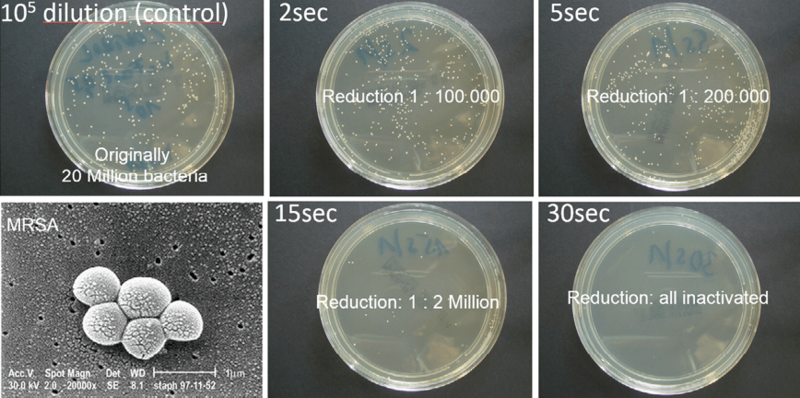 Figure 6: Plasma inactivation of antibiotics resistant bacteria - MRSA (bottom left). Several Petri dishes were prepared with about 20 million bacteria on each. On the top left is a control measurement - the bacteria solution was diluted by 100.000, then spread on the agar and incubated. Each ‘dot’ is a colony forming unit (CFU) of bacteria, grown after an incubation of typically 12-24 hours - starting from a single bacterium. Therefore, counting these ‘dots’ gives the number of bacteria originally present on the agar. If plasma treatment would be able to inactivate 99.999 per cent of bacteria, then the plasma treated Petri dishes should look like the control. The four fields on the right show the bacteria reduction for various plasma treatment times. The ‘dots’ now mark the single bacteria which survived the plasma treatment. Even after two seconds a reduction of 99.999 per cent is reached - after 30 seconds all MRSA bacteria are inactivated - to our knowledge this cold atmospheric plasma is the most effective bactericidal agent that is not harmful to human tissue.
Figure 6: Plasma inactivation of antibiotics resistant bacteria - MRSA (bottom left). Several Petri dishes were prepared with about 20 million bacteria on each. On the top left is a control measurement - the bacteria solution was diluted by 100.000, then spread on the agar and incubated. Each ‘dot’ is a colony forming unit (CFU) of bacteria, grown after an incubation of typically 12-24 hours - starting from a single bacterium. Therefore, counting these ‘dots’ gives the number of bacteria originally present on the agar. If plasma treatment would be able to inactivate 99.999 per cent of bacteria, then the plasma treated Petri dishes should look like the control. The four fields on the right show the bacteria reduction for various plasma treatment times. The ‘dots’ now mark the single bacteria which survived the plasma treatment. Even after two seconds a reduction of 99.999 per cent is reached - after 30 seconds all MRSA bacteria are inactivated - to our knowledge this cold atmospheric plasma is the most effective bactericidal agent that is not harmful to human tissue.
Physicists have opened up a new approach for improving our knowledge about the physics and dynamics of matter
For plasma medicine, in our case, it turned out that the detailed understanding of cold plasma physics, dynamics, chemistry and technology (including miniaturisation and associated problems that many years of research in space have taught us) were instrumental in developing a reliable plasma technology platform that is safe for human applications. This is the reason why the Max Planck Network of researchers was able to conduct the first and (still) by far the most comprehensive and largest clinical trials involving 379 patients and over 3000 plasma treatments over a time period of eight years (including follow-up).
A brief summary of the clinical studies is:
Chronic wound treatment
Aim was to reduce bacterial load in the chronic wounds to avoid re-infection and achieve faster healing. The study goals were achieved, plasma treated wounds had no re-infection and wound healing was speeded up. No negative side effects reported.
Wound healing
Aim was to investigate whether plasma treatment could speed acute wound healing. The study involved the treatment of skin graft wounds, the goals were achieved with wound healing typically 15-20 per cent faster. No negative side effects reported.
Skin diseases
The aim was to see if plasma treatment could reduce pain and lesions in Herpes Zoster (Shingles), a viral skin infection. The study goals were achieved - both pain and lesions were significantly reduced. No negative side effects reported.
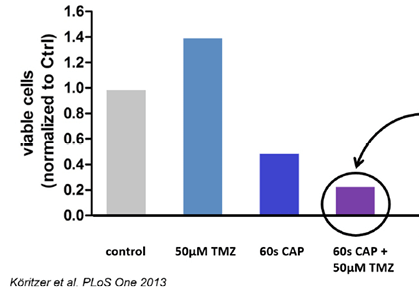 Figure 7: Combination therapy of LN18 Glioblastoma cells - using TMZ and CAP. These cell lines are resistant against chemotherapy (Temozolomide - TMZ). Application of TMZ alone leads to basically unrestrained growth (to about 140 per cent) of tumour cells compared to the control (see column 2). Applying cold atmospheric plasma (CAP) for 60 seconds reduces the viability of the tumour cells (to about 45 per cent) as seen in column three. Combined treatment gives an added effect - reduction of tumour cell viability to about 20 per cent. The plasma treatment has restored the sensitivity of the resistant LN18 cells to TMZ chemotherapy!
Figure 7: Combination therapy of LN18 Glioblastoma cells - using TMZ and CAP. These cell lines are resistant against chemotherapy (Temozolomide - TMZ). Application of TMZ alone leads to basically unrestrained growth (to about 140 per cent) of tumour cells compared to the control (see column 2). Applying cold atmospheric plasma (CAP) for 60 seconds reduces the viability of the tumour cells (to about 45 per cent) as seen in column three. Combined treatment gives an added effect - reduction of tumour cell viability to about 20 per cent. The plasma treatment has restored the sensitivity of the resistant LN18 cells to TMZ chemotherapy!
In addition, there were a number of individual clinical treatments (Hailey-Hailey disease, foot infection, ear infection with resistant bacteria) which could be healed after plasma application, even in cases where year-long standard antibiotic treatment had been unsuccessful. The important elements of the plasma treatment lie in the production of gaseous reactive species that effectively inactivate bacteria, viruses, fungi and spores as well as the production of gaseous species that further regenerative processes in human tissue.
Figure 6 shows the effectiveness of a particular plasma source, the ‘surface micro-discharge’ electrode, developed at the Max Planck Institute and hence developed further (to a ‘thin film electrode’) by terraplasma GmbH (a spin-off company from the Max Planck Society).
Before leaving the topic of plasma medicine, here is one more result (taken from over 50 research publications of the Max Planck Network). It highlights a research result that was totally unexpected - the possible application of cold atmospheric plasma in cancer treatment.
 Figure 8: A design for a plasma wound treatment device (design by Carolin Frontzek), as it could be used on Earth. Clearly, without modifications (e.g. a magnetic holder to the charger) this would not be suitable for space. Another issue is the plasma chemistry - under microgravity the transport of trace molecules is different than on Earth - it is not known how the chemistry changes and what this implies for the reactive products. Research and development under microgravity is necessary.
Figure 8: A design for a plasma wound treatment device (design by Carolin Frontzek), as it could be used on Earth. Clearly, without modifications (e.g. a magnetic holder to the charger) this would not be suitable for space. Another issue is the plasma chemistry - under microgravity the transport of trace molecules is different than on Earth - it is not known how the chemistry changes and what this implies for the reactive products. Research and development under microgravity is necessary.
The experiments are ‘in vitro’ using Glioblastoma cells (brain tumour). Brain tumour cells are difficult to treat - surgery is not easy, drug delivery across the blood-brain barrier is difficult, tumour growth is infiltrative and more than 40 per cent of tumours have chemotherapy-resistant glioma sub-populations.
Inevitably some of the results from experiments in space will find their way into applications on Earth
Cold atmospheric plasma produces over 600 non-equilibrium chemical reactions in air, although only three components play a role: oxygen, nitrogen and water vapour. These chemical reactions can be ‘designed’ to some extent to yield mainly anti-microbial properties (by producing the same reactive species as our own innate immune system - albeit in easily applied gaseous form) or regenerative properties (advancing wound healing).
So we have a potentially quite effective new medical agent - cold atmospheric plasma - which can be designed for different beneficial effects in health care. With the huge variability available for the many plasma states (see Figure 1 and comments), and with the correspondingly different plasma properties to apply in medical therapy, an interesting new approach is currently being developed in many research labs worldwide.
From Earth back to space
There is another important property of cold atmospheric plasma - it is a fully sustainable resource with no waste products and removal. Provided air and electrical power exists, these plasmas can be produced and employed.
Without air and electricity humans could not exist in space (or in other inhospitable environments, such as submarines). What this means is that to some extent, once the benefits of plasma applications have been proven and the technology for application under microgravity has been tested and established, a small miniature plasma dispenser could supplement current health care for astronauts. The possible topics are:
- Wound healing - under microgravity wounds do not close as fast as on Earth, speeding the process is important.
- Skin diseases - under microgravity the innate immune system becomes less efficient, supplementing the immune system in the fight against infections with plasma could be very beneficial.
- Air pollution - cold plasma can dissociate pollutants in air by various processes, e.g. electron impact dissociation or oxidation, providing a healthy environment.
- Water purification - tests have shown that bacteria and viruses in water can be inactivated very efficiently whilst retaining the drinking quality of the treated water. This can give added safety during long space missions where water has to be recycled many times.
- Surface disinfection - cold atmospheric plasma can disinfect sensitive materials without harming the treated devices. In addition, as a gaseous medium, it can access places that are ruled out to e.g. UV radiation or liquid disinfectants.
A current ‘Proof of Principle’ project is being financed by the German Space Agency (DLR), with support from the Russian IBMP (Institute for Biomedical Problems) and ESA, in order to explore the possibilities for cold atmospheric plasmas in space.
Thus the plasma research, which started in space and is being exploited in medicine on Earth, could now return to space for the benefit of the astronauts and cosmonauts, who carried out the original fundamental space experiments and who will no doubt continue the pioneering activities on the greatest and most challenging peaceful frontier which humanity needs to explore.





